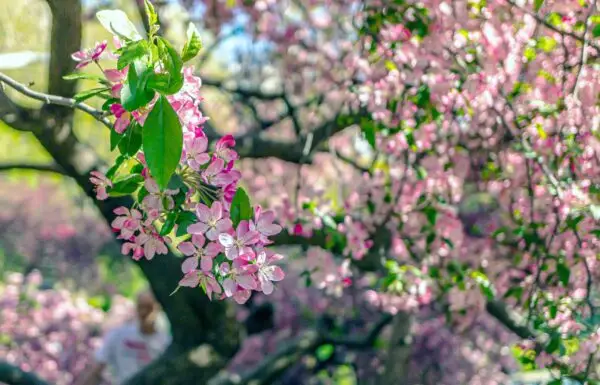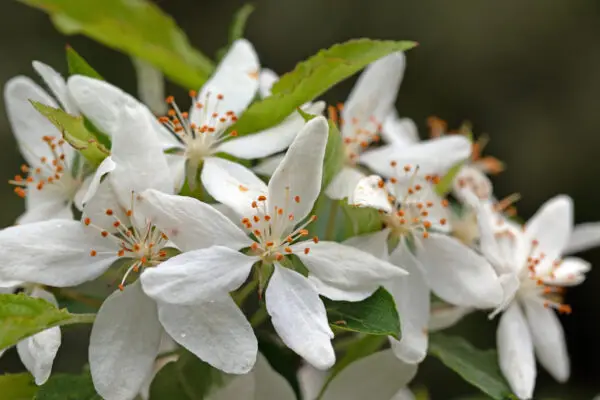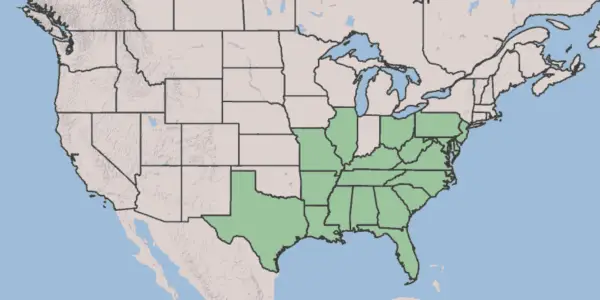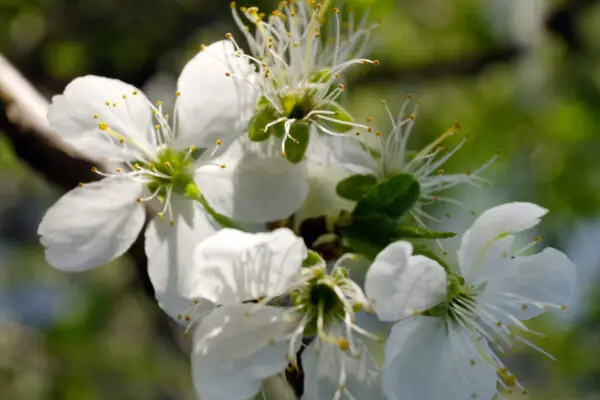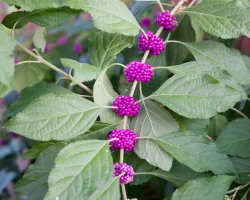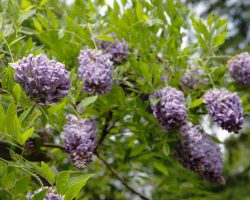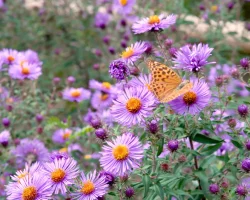Native crabapples are among the most beautiful native trees, putting out white to pink-hued flowers every spring. After the flowers come the miniature apples. The apples are edible but tiny—they are often used in jams and jellies due to their size. If cleaning up fallen apples in your yard in the fall sounds like a bummer, plant your native crabapples away from high-traffic areas where the fallen fruit won’t bother you. Scroll on to meet some native crabapple options.

The world is filled with fruiting trees, and North America is home to around four native crabapples. (The list ranges between 4-5 species.) In this article, we’ll introduce four native species, share planting tips, and include some sourcing recommendations.
Let’s start with a basic question all gardeners ask:

What are the benefits of planting native crabapples?
Planting native plants, including native crabapples, makes our yards gorgeous while helping the birds, butterflies, and animals (and saving us time.) Here are three reasons why planting native crabapples is worth it:
- Wildlife support. Native crabapples help give butterflies and songbirds the food and homes they need to survive.
- Native plants save time and money. After the first year of establishment, they thrive with normal rainfall.
- Native crabapples offer cinematic, seasonal beauty. Let’s move away from boring, static, non-native evergreens like boxwoods and enjoy a plant that changes dramatically with the seasons, like native crabapples.
And one more benefit to share…
Native crabapples are host plants
Native crabapples are essential for helping butterfly and moth populations.
Native crabapples are host plants for an astonishing 287 butterflies and moths. Notable butterfly and moth partners include the Red-Spotted Purple butterfly and Viceroy and Eastern Tiger Swallowtail butterflies. (Here’s a quick host plant overview if you’re wondering what it means.)
Native crabapples help all these butterflies and moths!




What is a host plant?
A host plant is a specific plant that a bug, butterfly, or caterpillar eats, lives on, or lays its eggs on.
We’ve covered the benefits; let’s dig into some individual options.
Meet North America’s native crabapples
Sweet Crabapple
Malus coronaria
Its ‘sweet’ common name comes from its sweet-smelling flowers in the spring. This tree has the most expansive native range of all the native crabapples. The champion American Crabapple (or the tallest of these species) is in Vermont!
- Size: Short tree, under 25 feet
- Flowers: Pink flowers, Apr-Jun
- Fruits: Yellow-gold, Sept-Oct
Southern Crabapple
Malus angustifolia
It’s common name makes you think it is only for the South, but its native range is more expansive, extending up to Pennsylvania and Illinois.
According to the North Carolina Gardener’s Toolbox, “Some states consider this native to be threatened or ‘of concern’ due to losses of native habitats or inadequate reseeding.”
- Size: Short tree, under 25 feet
- Flowers: Pink to white flowers, Feb-May
- Fruits: Yellow with reddish hues, Aug-Sept
- Evergreen in southern locations
Prairie Crabapple
Malus ioensis
Living in the Midwest? Here is the native crabapple for you.
- Size: Smallest of the native crabapples, topping out at 20 feet
- Flowers: Pink flowers, Apr-Jun
- Fruit: Yellow-green fruits, Aug-Sept
Oregon or Pacific Crabapple
Malus fusca
Living in the west coast, or even Alaska? This is the crabapple for your yard. According to Native Plants Pacific Northwest, it’s also the only native apple found on the west coast.
- Size: Small trees, topping out at 25 feet
- Flowers: White flowers, Apr-Jun
- Fruit: Warm yellow-orange fruits, Aug-Sept
Backyard Ecology has an excellent overview of three of the four native crabapples:
That’s the good news. Now let’s share a few things to consider, alongside some recommendations to help.
Common challenges with these native trees
Crabapples are known for a few shared issues:
They can messy
One bummer about planting native crabapples is crabapples on the ground in the fall. Some people find it bothersome to have a pile of fallen fruit that attracts wildlife like deer and squirrels.
Plant crabapples out of the way of houses or highly visible gardens to minimize the mess. Some ideas for placement that are out of the way include the edges of backyards or along long driveways.
Deer love them
Deer will happily snack on the fallen crabapples or the branches themselves. If you struggle with attracting deer, this might not be the native plant for you.
Explore our guide to Deer-Resistant Natives for alternatives.
Like all apple trees, they can attract pests and diseases
All fruit trees attract wildlife—bugs, birds, and animals. They also can be known for diseases, which can limit their lifespans. Here are some tips for keeping your native crabapples healthy:
- No pesticides = better chances of bug equilibrium. Keeping pesticides away from your garden will help the birds keep the bug populations in check. (Skeptical? It’s worth noting a chickadee family needs 6,000-9,000 bugs to feed a single nest!)
- Spacing around your crabapple ensures light + air. This cuts down on mold and ensures a happy plant.
- Sunlight helps. Crabapple trees in shady areas can increase the chances of diseases.

Where can I find native crabapples for my yard?
Crabapples are beloved plants in the plant nursery world; let’s ensure you get the right one. The Bernheim Arboretum in Kentucky notes, “Currently, there are over 1,000 horticultural varieties of crabapples, with more being added to the market every year.” (And they should know—their crabapple collection contains dozens of crabapple species.)
How do you find a native crabapple needle in this botanical haystack?
Look for the Latin
To make sure you’ve found a native crabapple, look for the Latin name on the nursery tag. Every plant has a single, consistent Latin name. It makes finding a specific plant 100000x easier, and it’s why Latin naming was invented.
We included the Latin botanical names for all the native crabapples; scroll up to find them. (And don’t be intimidated by botanical Latin! We all lived through a pandemic—you got this. Here’s a quick Latin pep-talk if you’d like one.)
There is one non-native you’ll find everywhere
The Japanese flowering crabapple (M. floribunda) is a larger tree than our North American crabapples, growing to 30-40 feet. This species is found in iconic locations like Central Park in NYC and is the basis for dozens of cultivars that fill conventional nurseries. (Unsure what a cultivar is? Here’s a quick cultivar overview.) Check the tag to be sure you’re planting native.
To make finding native crabapples even easier, here are four sourcing ideas to help you find one for your yard:
Where can I find seeds and plants?
Finding native plants can be challenging (we partly blame Marie Antoinette.) To make it easier, we’ve assembled four sourcing ideas.
300+ native nurseries make finding one a breeze
Explore 100+ native-friendly eCommerce sites
Every state and province has a native plant society; find yours
Online Communities
Local Facebook groups are a great plant source
What are good pairings for native crabapples?
Some so many fantastic native shrubs and flowers pair beautifully with native crabapples. Some ideas to consider include:

Pairs well with
With its stunning blossoms, and ease of care, native crapapples are statement trees any American landscape will benefit from. Planting native trees is not just about creating a beautiful garden; it’s about nurturing a sustainable and thriving ecosystem right outside your door. They are a beautiful flowering tree for Mid-Atlantic, Midwest, Northeast, or Southern gardens. Looking to build a native yard? Don’t forget to visit our Best Native Plants for Birds or our Best Native Trees for Front Yards. Happy planting!
Sources
- Nelson, Gil. Best Native Plants for Southern Gardens: A Handbook for Gardeners, Homeowners, and Professionals, (2010).
- Harstad, Carolyn. Go Native! Gardening with Native Plants and Wildflowers in the Lower Midwest. (1999), 209-210.
- Wildflower.org. Malus ioensis. Lady Bird Johnson Wildflower Center – the University of Texas at Austin, 2019.
- Wildflower.org. “Lady Bird Johnson Wildflower Center – the University of Texas at Austin,” 2020. https://www.wildflower.org/plants/result.php?id_plant=maan3.
- Wildflower.org. “Lady Bird Johnson Wildflower Center – the University of Texas at Austin,” 2023. https://www.wildflower.org/plants/result.php?id_plant=maco5.
- “Malus Coronaria (American Crabapple, Garland Crab, Sweet Crabapple, Wild Crabapple),” North Carolina Extension Gardener Plant Toolbox, 2025.
- “Malus Angustifolia (Narrowleaf Crab, Narrowleaf Crabapple, Southern Crabapple, Wild Crab, Wild Crabapple)” North Carolina Extension Gardener Plant Toolbox, 2025.
- Penn State Extention, Master Gardener. “Butterfly Larval Host Plant List,” 2017.
- Master Gardeners of Northern Virginia, “Sweet Crabapple.” Tried and True Native Plant Selections for the Mid-Atlantic, n.d.
- Johnson, Ken. “In the Arboretum: Crabapple Collection.” Bernheim Forest and Arboretum, February 8, 2024.
- Cornell Cooperative Extension Monroe County, “Host Plants for Butterflies.” n.d.
- Hyles Lineata. “Sphingidae of the United States of America,” 2024.
- “Pacific Crabapple, Malus Fusca.” Native Plants PNW, November 17, 2014.
- Calscape. “Oregon Crab Apple.” Calscape.org, 2025.
- PollinatorWeb. “Host Plant Table,” January 24, 2022.
- Master Gardeners of Northern Virginia. “Nectar and Host Plants for Selected Mid-Atlantic Butterflies and Moths,” June 24, 2022.
- National Wildlife Federation, “Plant Information – Native Plants Finder,” 2015.
- Tallamy, Douglas W. “Opinion | in Your Garden, Choose Plants That Help the Environment.” Nytimes.com. The New York Times, March 11, 2015.
Native flowering trees
What if your feed was actually good for your mental health?
Give your algorithm a breath of fresh air and follow us.

